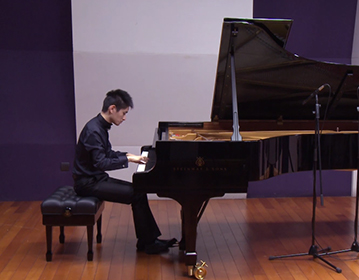Piano: Yizhe Sun
Program: Piano Sonata No. 17 in D minor
Composer: Beethoven
Sonata in d minor (‘Tempest’), Op.31 no.2 Ludwig van Beethoven (1770-1827)
Largo – Allegro
Adagio
Allegretto
Beethoven was a transitional composer between the classical period and the romantic period, and this piano sonata in d minor is also a piece in which his own style incorporated the styles of both periods. It is a major piece for him during his middle ages, as well as a major turning point. It was written in the summer of 1802, around the same time he wrote the Heiligenstadt Testament. This is a marked turning point in his life, as it is in these months that Beethoven found the hopes and the meanings of his life.
The whole sonata can be compared to a journey in search of something, and it starts with a broken chord that is similar to a remote thunder, earning itself the name of ‘the Tempest’. The chord with peacefulness is then interrupted by rapid quavers that remind listeners of rain drops. This is definitely not a conventional opening for a sonata, as it represents the complex feelings that Beethoven was having by juxtaposing two completely different moods. The ‘storm’ then takes over to become the exposition theme. The exposition consists of three parts, the first filled with tremolos, the second with some kind of mystery, and the third more relaxed. In all three themes we can see the appearance of the typical ‘foreshortening’ in Beethoven: for instance, from long sentences in bars 20-28 to short ones following. The peaceful chords comes back after the exposition, but also foreshadows the more rampant development. The sonority in the development is far more intense than in the exposition, but in the end it still leads to the chords that signifies the start of the recapitulation. In this part, however, a long recitative is included, with the mark con espressione e semplice. This should be achieved without changes in the tempo, satisfying the semplice part, as Beethoven himself wouldn’t be prone to be too emotional. Then, with a mysterious three lines of arpeggios, the recapitulation returns to its normal form, ending the movement in quietness (with yet more foreshortenings).
The second movement begins in serenity with a B-flat major chord. Many of its melodies are reminiscent of the first movement’s motifs. For example, the main rhythmic pattern echoes the rhythm in the recitative in the first movement. However, unlike the rampant first movement, the second movement is more introvert (although the sonata as a whole is introvert). It’s more like a man’s own expression about something. In this movement, we are also introduced to another typical Beethoven technique: abrupt dynamic changes from forte to piano. For example, this can be seen at bars 26-27. This is very useful at creating contrasts in mood. Another interesting thing about the movement is the arpeggios in the middle part. This further adds mystery and sophistication to the movement.
The final movement of the sonata is a mixture of the sonata form and the rondo, with perpetual semiquavers flowing from beginning to end. The theme also stems from the first movement, as both of them centre on the d minor chord. The third movement in some ways can even be tenacious, as it just develops on the very simple rhythmic pattern and goes on over and over. The tempo remains more or less the same, but the piece is far from being boring. We can hear hemiolas starting from bar 43, dialogues between hands in the development, which finally leads to a climax. The ending of the movement, as well as the whole sonata, is also Beethovenish, as it came to an abrupt end when listeners might be wanting more. There are no fortes, no chords, just a single d that brings the whole piece to the end. This might as well signify the fact that this piece is just a searching journey, and its end might not be the very end of music.

